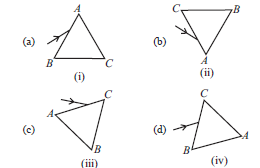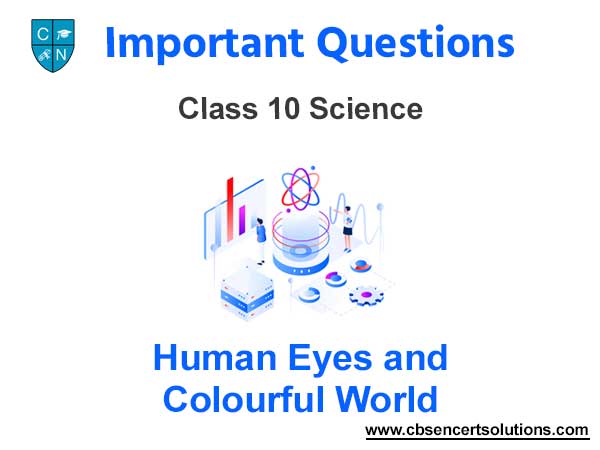Please refer to Chapter 11 Human Eyes and Colourful World Case Study Questions with answers provided below. We have provided Case Study Questions for Class 10 Science for all chapters as per CBSE, NCERT and KVS examination guidelines. These case based questions are expected to come in your exams this year. Please practise these case study based Class 10 Science Questions and answers to get more marks in examinations.
Case Study Questions Chapter 11 Human Eyes and Colourful World
Case/Passage – 1
Human eye is spherical in shape and has diameter of about 2.5 cm. Sclerotic is a tough, opaque and white substance forming the outermost coating of the eyeball. The front portion
is sharply curved and covered by a transparent protective membrane called the ‘cornea’. Inner to the sclerotic there is a layer of black tissue called as choroids consisting of a mass of blood vessels, which nourishes the eye. The black colour does not reflect the light and hence rules out the blurring of image by reflection within the eyeball.
Behind the cornea, the space is filled with a liquid called the aqueous humour and behind that a crystalline lens. ‘Iris’ is a muscular diaphragm lying between the aqueous humour and the crystalline lens. Iris has an adjustable opening in the middle called the pupil of the eye. The pupil appears black because all the light entering is absorbed by the ‘retina’, which covers the inside of the rear part of the ball. Iris controls the amount of light entering because the retina absorbs nearly all the light, which falls upon it. This is done by varying the aperture of the pupil with the help of the iris. In dim light the iris dilates the pupil so that more light can enter in. When the light is bright the pupil contracts.
The crystalline lens divides the eyeball into two chambers.The chamber between the cornea and the lens is called the anterior chamber filled with a fluid called aqueous humour while the chamber between the lens and the retina is called the posterior chamber which is filled with a transparent gelatinous substance called vitreous humour.
The refractive indices of the cornea, pupil lens and fluid portion of the eye are quite similar. So, when a ray of light enters the eye, it is refracted at the cornea. This refraction produces a real inverted and diminished image of distant objects on the retina.
When the object is kept at different distances then, we may expect the image to be formed at different distances from the lens. It means, it may not form on the retina always.
But in reality it is not so. Image is always formed on the retina. This is possible because the curvature of the crystalline lens is altered by ciliary muscles. When the eye is focused on infinity the muscles are relaxed and the eye lens remains thin. If the object is brought near by, the curvature increases so that the image can be formed on the retina. This property of the eye lens is called accommodation.
Question: The fluid between the retina and the lens is called ______
(a) aqueous humour
(b) vitreous humour
(c) aqua
(d) humus
Answer
B
Question: The part of the eye where optic nerves enter the eye
(a) pupil
(b) ciliary muscles
(c) retina
(d) blind spot
Answer
D
Question: The change in focal length of an eye lens to focus the image of objects at varying distances is done by the action of _______
(a) pupil
(b) ciliary muscles
(c) retina
(d) blind spot
Answer
B
Question: The inner back surface of the eyeball is called
(a) pupil
(b) ciliary muscles
(c) retina
(d) blind spot
Answer
C
Case/Passage – 2
The phenomenon of decomposition of the white light into its seven component colours when passing through a prism or through a transparent object delimited by non parallel surfaces is called dispersion of light. A beam of light containing all the visible spectrum of the light is white, because the sum of all the colors generates the white color. The light is decomposed in all the component colours, Violet, Indigo, Blue, Green, Yellow, Orange and Red, called as VIBGYOR. The band of the coloured components of a light beam is call d its spectrum.
The phenomenon can be explained by thinking that light of different colours (different wavelengths) has different velocities while travelling in a medium vm = f λm. Hence, the change in velocity of light observed when the light passes from the air to the glass, depends on the wavelength.
Question: A prism ABC (with BC as base) is placed in different orientations. A narrow beam of white light is incident on the prism as shown in figure. In which of the following cases, after dispersion, the third colour from the top corresponds to the colour of the sky?

Answer
B
Question: When white light is allowed to pass through a glass prism, which colour deviates the most?
(a) Indigo
(b) Green
(c) Red
(d) Violet
Answer
D
Question: Which of the following statements is correct regarding the propagation of light of different colours of white light in air?
(a) Red light moves fastest
(b) Blue light moves faster than green light
(c) All the colours of the white light move with the same speed
(d) Yellow light moves with the mean speed as that of the red and the violet light
Answer
C
Question: For a prism material,refractive index is highest for
(a) Red
(b) Yellow
(c) Orange
(d) Violet Passage Based Questions
Answer
D
Question: When white light is allowed to pass through a glass prism,which colour deviates the least?
(a) Violet
(b) Red
(c) Green
(d) Orange
Answer
B
Case/Passage – 3
The ciliary muscles of eye control the curvature of the lens in the eye and hence can alter the effective focal length of the system. When the muscles are fully relaxed, the focal length is maximum. When the muscles are strained the curvature of lens increases (that means radius of curvature decreases) and focal length decreases. For a clear vision the image must be on retina. The image distance is therefore fixed for clear vision and it equals the distance of retina from eye-lens. It is about 2.5 cm for a grown-up person.
A person can theoretically have clear vision of objects situated at any large distance from the eye. The smallest distance at which a person can clearly see is related to minimum possible focal length. The ciliary muscles are most strained in this position. For an average grown-up person minimum distance of object should be around 25 cm. A person suffering for eye defects uses spectacles (Eye glass). The function of lens of spectacles is to form the image of the objects within the range in which person can see clearly. The image of the spectacle-lens becomes object for eye-lens and whose image is formed on retina.
The number of spectacle-lens used for the remedy of eye defect is decided by the power of the lens required and the number of spectacle-lens is equal to the numerical value of the power of lens with sign. For example power of lens required is +3D (converging lens of focal length 100/3 cm) then number of lens will be +3.
For all the calculations required you can use the lens formula and lens maker’s formula. Assume that the eye lens is equiconvex lens. Neglect the distance between eye lens and the spectacle lens.
Question: Maximum focal length of eye lens of normal person is
(a) 25 cm
(b) 2.5 cm
(c) 25/9 cm
(d) 25/11 cm
Answer
B
Question: Minimum focal length of eye lens of a normal person is
(a) 25 cm
(b) 2.5 cm
(c) 25/9 cm
(d) 25/11 cm
Answer
D
Question: A nearsighted man can clearly see object only upto a distance of 100 cm and not beyond this. The number of the spectacles lens necessary for the remedy of this defect will be
(a) +1 D
(b) –1 D
(c) + 3 D
(d) – 3 D
Answer
B



